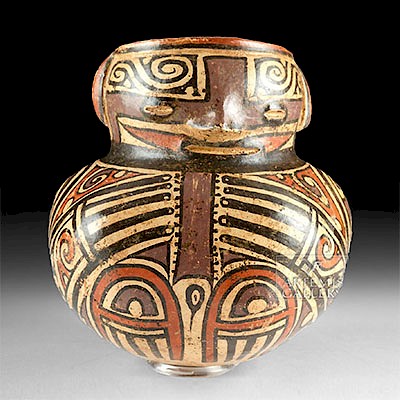Greek Gnathian Pottery Epichysis
Lot 17d
About Seller
Artemis Fine Arts
686 S Taylor Ave, Ste 106
Louisville, CO 80027
United States
Selling antiquities, ancient and ethnographic art online since 1993, Artemis Gallery specializes in Classical Antiquities (Egyptian, Greek, Roman, Near Eastern), Asian, Pre-Columbian, African / Tribal / Oceanographic art. Our extensive inventory includes pottery, stone, metal, wood, glass and textil...Read more
Estimate:
$900 - $1,350
Absentee vs Live bid
Two ways to bid:
- Leave a max absentee bid and the platform will bid on your behalf up to your maximum bid during the live auction.
- Bid live during the auction and your bids will be submitted real-time to the auctioneer.
Bid Increments
| Price | Bid Increment |
|---|---|
| $0 | $25 |
| $300 | $50 |
| $1,000 | $100 |
| $2,000 | $250 |
| $5,000 | $500 |
| $10,000 | $1,000 |
| $20,000 | $2,500 |
| $50,000 | $5,000 |
| $100,000 | $10,000 |
| $200,000 | $20,000 |
About Auction
By Artemis Fine Arts
Nov 8, 2018
Set Reminder
2018-11-08 10:00:00
2018-11-08 10:00:00
America/New_York
Bidsquare
Bidsquare : Ancient / Ethnographic From Around The World
https://www.bidsquare.com/auctions/artemis-gallery/ancient-ethnographic-from-around-the-world-3598
Ancient art from Egypt, Greece, Italy and the Near East, as well as Asian, Pre-Columbian, Native American, African / Tribal / Oceanic, Spanish Colonial, Russian Icons, Fine art, much more! Artemis Fine Arts info@artemisgallery.com
Ancient art from Egypt, Greece, Italy and the Near East, as well as Asian, Pre-Columbian, Native American, African / Tribal / Oceanic, Spanish Colonial, Russian Icons, Fine art, much more! Artemis Fine Arts info@artemisgallery.com
- Lot Description
Magna Graecia, southern Italy, near Ignazia, Apulia, ca. 325 BCE. A beautiful pottery pouring vessel known as an epichysis. The vessel possesses a characteristically spool-shaped base with a curved lower body leading to a tubular neck and a slender spout joined to the shoulder by a high, raised handle, with applied matching anthropomorphic heads adorning the areas where the upper handle end meets the spout. The vessel is finely painted via the Gnathian technique with a fretted band, a dotted band, registers of leaf-like forms and grape bunches separated by a slender band, dots alternating with "V"s along the upper end of the spool, and a concentric ring and an undulating curvilinear form on the center of the spool, all in fugitive red, white, and yellow-orange paint. Size: 3.5" W x 6.7" H (8.9 cm x 17 cm).
Gnathia ware is named for the site where it was first discovered - the Apulian site of Egnathia (also Gnatia, Egnatia, Ignazia). The black glaze ware is traditionally decorated with floral and other decorative motifs in red, white, and/or yellow hues. Scholars believe that its production most likely was centered around Taras, with primary workshops in Egnathia and Canosa. The quantity and quality of Greek colonial Apulian potters increased significantly following the Peloponnesian War when Attic exports dramatically decreased. Apulian artistry demonstrates influences of Ionian (Athenian, Attic) conventions, as well as Doric (western colonial Greek) styles, with a palpable native Italian aesthetic.
Provenance: private East Coast, USA collection
All items legal to buy/sell under U.S. Statute covering cultural patrimony Code 2600, CHAPTER 14, and are guaranteed to be as described or your money back.
A Certificate of Authenticity will accompany all winning bids.
We ship worldwide and handle all shipping in-house for your convenience.
#137787Neck and handle reattached to lower body with small nicks and light adhesive residue along break lines. Surface wear and abrasions commensurate with age, small chips to base, body, spout, and handle, with fading to pigmentation in some areas, and light roughness across most surfaces. Nice earthen deposits and traces of original pigmentation throughout. Two old inventory labels beneath base.Condition
- Shipping Info
-
All shipping is handled in-house for your convenience. Your invoice from Artemis Gallery will include shipping calculation instructions. If in doubt, please inquire BEFORE bidding for estimated shipping costs for individual items.
-
- Buyer's Premium



 EUR
EUR CAD
CAD AUD
AUD GBP
GBP MXN
MXN HKD
HKD CNY
CNY MYR
MYR SEK
SEK SGD
SGD CHF
CHF THB
THB
















